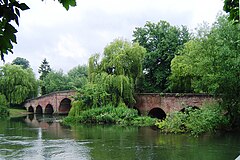Sonning Eye: Difference between revisions
Disambiguated: Sunna → Sunna (Saxon chief) |
→External links: Removed ref to Sonning & Sonning Eye Community Website. It' s now something in Chinese |
||
| Line 61: | Line 61: | ||
* [http://www.seag.org.uk/ Sonning Eye Action Group] |
* [http://www.seag.org.uk/ Sonning Eye Action Group] |
||
* [http://www.sonning.org.uk/ Sonning & Sonning Eye Society] |
* [http://www.sonning.org.uk/ Sonning & Sonning Eye Society] |
||
* [http://www.sonning.net/ Sonning & Sonning Eye Community Website] |
|||
* [http://www.thefrenchhorn.co.uk/ The French Horn hotel and restaurant] |
* [http://www.thefrenchhorn.co.uk/ The French Horn hotel and restaurant] |
||
* [http://www.millatsonning.com/ The Mill at Sonning dinner theatre] |
* [http://www.millatsonning.com/ The Mill at Sonning dinner theatre] |
||
Revision as of 19:19, 5 August 2012
| Sonning Eye | |
|---|---|
 Sonning Bridge from the Sonning Eye bank of the River Thames | |
| OS grid reference | SU7576 |
| Civil parish | |
| District | |
| Shire county | |
| Region | |
| Country | England |
| Sovereign state | United Kingdom |
| Post town | Reading |
| Postcode district | RG4 |
| Dialling code | 0118 |
| Police | Thames Valley |
| Fire | Oxfordshire |
| Ambulance | South Central |
| UK Parliament | |
| Website | Eye & Dunsden Parish Council |
Sonning Eye is a hamlet on the River Thames in Oxfordshire, England, in the civil parish of Eye & Dunsden, at the very southernmost tip of Oxfordshire.
Overview
Until 1866, Sonning Eye formed part of the Oxfordshire section of Sonning civil parish.[citation needed] It is about 3 miles (4.8 km) northeast of Reading, Berkshire. Sonning Eye is opposite the village of Sonning, Berkshire, to which it is linked by the historic brick-arched Sonning Bridge and the more modern Sonning Backwater Bridges.
The toponym "Sonning" is derived from the Viking name Sunna and "Eye" meaning island (cf. eyot) since it is a small gravel mound surrounded by the river's flood plain. There is also a true islet at Sonning Eye between two branches of the Thames.
The heart of Sonning Eye is a conservation area and there are a number of notable Grade II listed buildings including several historic barns that have now been converted for modern use. One house has some excellent William De Morgan tiles.
Sonning Eye is surrounded by the alluvial floodplain of the River Thames, much of which has been extracted for gravel, forming a number of lakes. In particular, a rowing lake has now been formed, named the Redgrave Pinsent Rowing Lake, after Olympic oarsmen Steve Redgrave and Matthew Pinsent. Other local sports include sailing and water skiing. Berry Brook runs through the floodplain west and north of Sonning Eye, joining the Thames at Hallsmead Ait to the northeast.
On the riverside near the Sonning Backwater Bridges is the French Horn, a luxury hotel and restaurant. There is a small public car park here, a place to launch small boats, and a grass area by the river bank that is popular with fishermen.
On the islet is The Mill at Sonning, an 18th century watermill now a converted dinner theatre.[1] The millrace runs through what is now the theatre bar, and powers a small turbine powering an 18.5 KW hydroelectric generator that supplies the National Grid.[2]
The area has been a favourite location for artists, especially views of the old brick bridge from the river bank just downstream of the bridge. George Price Boyce, the Victorian watercolour painter associated with the Pre-Raphaelite art movement, visited and painted in the area.[3]
Gallery
-
Print of Sonning Bridge (1799), linking Sonning Eye (right) with Sonning (left) and St Andrew's Church tower in the background.
-
View from the main Sonning Backwater Bridge along the B478 road in Sonning Eye with the French Horn hotel on the right.
-
Waterside cottages at Sonning Eye.
-
View of the B478 road in the snow with the French Horn in the background.
See also
- Islands in the River Thames
- Sonning Bridge
- Sonning Regatta
- Caversham Lakes
- Redgrave Pinsent Rowing Lake
- List of places in Oxfordshire
- List of civil parishes in England
References
- ^ The Mill at Sonning.
- ^ The Mill at Sonning: Hydro Scheme.
- ^ At Sonning-eye, Oxfordshire by George Price Boyce, 1860. (Sold at Christie's, London, 1997.)





